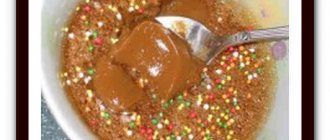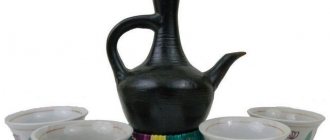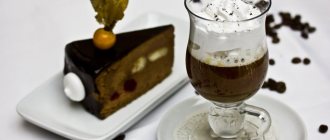Surely many of you have repeatedly dreamed of making homemade cappuccino without paying a lot of money for fancy coffee machines. Or maybe you're tired of spending all your money on your daily cup of cappuccino at your local coffee shop? Well, you can make homemade cappuccino quite easily and using many simple methods.
You can use the so-called Indian method of whisking instant coffee with a little sugar and water before adding milk, or simply whisk it with some heated milk in a can and add it to the instant coffee. Moreover, if this process seems too long for you, you can even make your own dry cappuccino mix and simply fill it with hot water for a delicious drink.
In this article we will look at 3 different ways to make homemade cappuccino from regular instant coffee and without any frills, coffee machines and other equipment.
If you don’t like instant coffee and the idea of using it to make homemade cappuccino, we advise you to try it first, and only then judge whether it turned out delicious or not. For example, Nescafe coffee makes a delicious cappuccino, and you can choose the right coffee on the website https://filizhanka.com/products/kofe/proizvoditel=nescafe/. Here you can even find 100% Arabica instant coffee, which will definitely appeal to many drink connoisseurs.
Classic preparation
First, prepare a shot of espresso. It is better to use a coffee machine. You will need 40ml of the drink and in ideal conditions you will need a porcelain cup that retains heat for a long time. Then whisk the milk - it should be cold, so take it out of the refrigerator immediately before whisking.
If possible, use a cappuccino maker in your coffee machine. Dip its spout into a glass of milk, but not to the bottom, otherwise foam will not form. Whip the milk until thick foam forms. If you don't have a cappuccino maker, use a mixer or blender.
Choose a glass in which coffee takes up about 1/3 of the volume, and pour milk foam on top in a thin stream. If the dishes are transparent, you should end up with two clearly separated layers - this looks very attractive. If the cup is opaque, you can mix coffee with foam - you get the so-called melange. In both cases, part of the foam should be placed on top with a spoon.
Cooking features
Coffee lovers only recognize drinks that are made from ground beans. Moreover, the fresher the grind, the better. Such an opinion is a tribute to tradition. Previously, the food industry could not completely replicate the taste of natural cappuccino. Only a surrogate drink was made from instant coffee. The taste is similar, but clearly far from the original.
Now the situation has changed dramatically. The capabilities of the food industry make it possible to perfectly convey all the notes of taste. Sometimes even gourmets cannot distinguish instant coffee from coffee brewed in a Turk or prepared in a coffee machine. When preparing such a drink, you need to take into account several important features:
The more expensive the instant coffee, the better it is. Cheap brands are seriously inferior in taste to expensive ones.
The brewing temperature specified by the manufacturer must be observed.
Cappuccino from instant coffee should be made taking into account the proportions of coffee and milk. Some gourmets believe that there should be twice as much milk and milk foam. Others believe that the total proportion of milk and milk foam should be equal to the volume of coffee.
Cappuccino should be poured into heated mugs.
Vanilla cappuccino
To prepare a vanilla drink, you need to do the following:
- We brew espresso in the same way. If you are using a coffee pot rather than a coffee machine, it is better to strain the drink.
- Add sugar to taste.
- Bring the heavy cream to a boil - you will need about 130-150 ml. We also add a little vanilla to them. Heat the cream very hot, but do not boil - this is important!
- Whip the hot cream until thick foam with a mixer or cappuccino maker.
- Spread foam on coffee.
Cappuccino making technology
Cappuccino is an Italian coffee drink made with double espresso, hot milk and steamed milk foam on top. Cream can be used in place of milk and is often sprinkled with cinnamon. It is generally smaller in volume than a latte with a thicker layer of foam. Foam is steamed milk that has been foamed, in which the bubbles are so small and so numerous that they are not visible, but this makes the milk lighter and thicker.
This will ensure that the foam remains partially on top of the mug when the espresso is poured correctly and also mixes well with the rest of the drink. It is usually made using an espresso machine. Double espresso is poured into the bottom of the cup, followed by the same volume of hot milk, which is obtained by heating the milk using the steam wand of the espresso machine. The top part consists of milk foam, it can be decorated with cinnamon and various designs, it all depends on the dexterity of the barista.
Chocolate
This recipe is more complicated and takes more time, but the result is a unique drink:
- First, we prepare traditional hot chocolate: pour 60 ml of milk into a Turk, heat it up strongly, but do not boil. Pour in 50-60 g of crushed chocolate and melt it. Hot chocolate is ready.
- Whip 30% heavy cream until thick foam. It will take about 70-80 ml.
- We brew rich coffee in a coffee machine or Turk.
- Prepare a cup or tall transparent glass. Pour coffee into the bottom, and then slowly pour hot chocolate over a spoon or knife blade. It is important to prevent it from sinking to the bottom.
- Spread a stiff foam of cream on top, and sprinkle cinnamon on top.
History of cappuccino
Before this drink appeared, as we know, there were variants of coffee, which eventually turned into cappuccino. Coffee was first prepared by boiling a mixture of coffee and water along with the addition of sugar. This was known as the traditional Ottoman preparation of the drink. In the second half of the 17th century, the British began filtering their coffee, and the fashion quickly spread to France and other parts of Europe. Adding milk to coffee was also known in Europe in the 17th century and was even recommended.
Cappuccino comes from the Kapusiner coffee drink, which first appeared in Viennese coffee houses in the 1700s. It was coffee with cream and sugar or coffee with cream, spices and sugar. Whipped cream was used for this version. This type of coffee, when made elsewhere, was called "Viennese Coffee" or "Cafe Viennois" outside of Vienna. Its name also cappuccino comes from the Capuchin monks, referring to the color of their robes.
Cappuccino, as it is known today, first appeared in Northern Italy in the 1930s. It was first made "Viennese" style with whipped cream that was sprinkled with cinnamon or chocolate. The option with steamed milk appeared later. True espresso machines only became widespread in the 1950s, and people began making cappuccinos with espresso instead of standard coffee. In this form, cappuccino has been known all over the world up to this point. Kapusiner remains a fixture on the Austrian coffee menu.
The ancestor of cappuccino has delighted coffee connoisseurs with its taste since 1700
Instant coffee cappuccino
If you don’t have natural coffee, a coffee machine, or even a Turk, you can use a regular instant drink to make cappuccino. Of course, it is not so refined, but it is also quite tasty. The algorithm of actions is as follows:
- Heat 120-150 ml of milk until almost boiling.
- Pour it into a jar with a tightly screwed lid (it is advisable that the milk fills it no more than half).
- Close the lid, wrap it in a towel and vigorously shake the jar so that the milk froths.
- Then brew instant coffee - about 60-70 ml. If necessary, add sugar immediately. The drink should fill the glass 1/3 full.
- Pour in the whipped milk, and spoon out the foam that has lingered on the walls of the jar on top.
This is how you can prepare a delicious cappuccino in a few minutes from ingredients that are found in every home, and without a coffee machine.
Indian style homemade cappuccino
Below we list all the ingredients per serving. If you have instant espresso on hand, you can use ½ teaspoon regular instant coffee and ½ teaspoon instant espresso together to make a homemade cappuccino.
Ingredients:
- 1 ½ teaspoons instant coffee
- 1 tablespoon sugar
- ¾ teaspoons water
- 1 glass of milk
Recommendations for making homemade cappuccino:
- The first thing you need to do with this method of making homemade cappuccino is to prepare the coffee mixture. While the milk is heating up, you can start preparing it. To do this, mix coffee and sugar in a coffee mug. Then you need to add ¾ teaspoon of water. Beat this mixture with a spoon for about 5 minutes or until it turns light brown.
- Heat a glass of milk in a saucepan and place the pan with the milk on a medium-high burner. Be sure to keep an eye on the milk and wait until it starts to bubble and rise. As soon as the milk has risen, remove it from the stove.
- Add the heated milk to the previously obtained coffee mixture. Stir the mixture until a good foam forms.
Sprinkle some instant coffee over the foam to garnish if you like, then try a homemade cappuccino the Indian way.
Coffee with foam in Turk
Turkish coffee was prepared long before the appearance of carob coffee makers. The height and stability of the foam largely depend on the content of essential oils in ground coffee. They dissipate very quickly, so if you brew a drink from beans that were ground more than 2 weeks ago, you should not expect thick and high foam. The ideal option is freshly ground coffee.
To brew Turkish coffee with foam, you need to choose the right strength of the drink. A decent amount of foam appears if 8–10 g of ground coffee is poured into 100 ml of water. The classic proportion is: 160 ml of water – 18 g of coffee. If there are less than 6 g of ground grains per 100 ml of water, in most cases you will not get foam.
When water is heated in the Turk, pressure arises, which is higher, the narrower the neck of the vessel. If the diameter of the neck is equal to or greater than the diameter of the bottom, the foam will be thin, fragmented, and quickly disappear.
To obtain foam, Turkish coffee should be poured in a gentle stream.
Conditions for obtaining foam for Turkish coffee:
- freshly ground grains;
- concentration is not less than 8–10 g of ground coffee per 100 ml of water;
- the diameter of the neck of the cezve is at least 20% less than the diameter of the bottom;
- soft bottled water. Boiled and chlorinated water is not suitable.
Recipe
Ground coffee (dust or slightly coarser) is poured with water at room temperature, wait about a minute until the air bubbles come out (the “blooming” ends), then put on low heat. After a minute, the coffee is stirred. The water in the Turk should not boil. The vessel is removed from the heat as soon as the foam begins to rise and is no longer heated. Coffee with foam is poured into heated cups and wait a few minutes for the grounds to settle.
How to brew coffee in drip bags
Each coffee portion is packed in foil. Inside the package there is a bag of the same filter paper. In the upper part there are elements made of thick cardboard. Further algorithm of use:
- Straighten the cardboard handles of the bag and pull them to the sides.
- In this case, the filter will open to its full width - the cardboard handles will be opened in two directions. Inside the filter bag are ground coffee beans.
- Fix the handles on the cup.
- Slowly pour hot water through the bag in a thin stream.
- Leave the poured drink to steep for a couple of minutes.
- Remove the bag from the mug by the handles and discard it.
Instructions for brewing coffee in drip bags
Making milk foam at home
To make coffee with thick milk foam at home, you can use a mixer, whisk or French press. To do this, take both custard and soluble bases. Before whipping, the milk must be heated in the microwave, in a water bath or over low heat. It is important not to bring it to a boil or even exceed 80°C.
Place a mixer or hand whisk in warm milk and whisk vigorously until medium bubbles form, moving the device evenly throughout the entire thickness of the liquid. You can pour in and beat the milk in a French press, often lowering and raising the plunger until the mousse is stiff. Before making coffee with foam, do not mix the tea leaves with milk, otherwise the cream will quickly settle.
Choosing milk
Different milks have their own advantages and disadvantages. Many people advise using skim milk or milk with a low fat content, up to 2%, for homemade cappuccino. This kind of milk is really easier to whip, the foam is dry, airy, with large bubbles. But it quickly disintegrates into a layer of foam and regular hot milk. To prepare a smooth drink with low-fat milk, you need to pour it into the coffee immediately after whipping.
Higher fat milk—from 3.5% fat—needs to be whipped more intensely to achieve the desired texture. But with such milk the drink will be more homogeneous, creamy and tender. True, the taste of milk can drown out coffee, so it is better to prepare small drinks with full-fat milk in order to achieve a balance of taste.
It is important that the milk contains 3% protein (or more). Milk proteins act as stabilizers and are responsible for creating a stable foam.
Plant milk for homemade cappuccino? Why not! True, not all types of it are suitable for whipping. However, among the variety of options, you can find ones suitable for your cappuccino. I wrote about what kind of plant milk there is and what difficulties you may encounter when choosing it here.
Secrets of creating foam on coffee
When brewed correctly, grain and instant black coffee produces a golden, aromatic cream. Usually it spreads along the edges of the cup, but sometimes it fills the surface with a soft layer - this indicates freshness and good technique for preparing the drink. This effect is achieved by observing the following important nuances:
- Crema is formed from freshly ground grains that are kept without oxygen. The air bubbles react with the coffee's fatty acids, producing a foamy reaction. The weathered thicket will no longer produce persistent foam.
- In order for bubbles to form, the drink must be in a light dynamic state - bubbling over heat, but not too strong, and stirring.
- A classic Turk with a narrow neck is better suited for brewing foamy coffee.
- In milk foam, its texture and durability are important, which depend on the composition of the creamy component, temperature and technique for creating the cream.
Making the right coffee at home is no more difficult than with professional equipment - you just need to follow the sequence and choose the right ingredients. And the tool can be found in any apartment or office - microwave, spoon, cup, French press.
Harmful ingredients
Aspartame (E951)
It is a sweetener that is 180 times sweeter than sugar. In the 1980s, scientists started talking about the fact that it worsens mood, sleep and appetite, and reduces serotonin levels. The tests carried out refuted this.
A study conducted by doctors at Massachusetts General Hospital showed that aspartame blocks the PRA protein. It helps regulate metabolism and burn fat. The food additive E951 disrupts metabolism.
Acesulfame potassium (E950)
This is a food additive that is 190 times sweeter than sugar. It has a bitter and metallic aftertaste, so to improve the taste, manufacturers additionally add aspartame.
Scientists consider the sweetener acesulfame to be relatively harmless. It does not destroy teeth and does not affect metabolism. On the other hand, the supplement increases appetite and leads to overeating. It causes dehydration, headache, and insomnia.
Sodium cyclamate (E952)
It is a sweetener that is 40 times sweeter than sugar. It is strictly forbidden to be taken by pregnant women.
Once in the body, the food additive reacts with intestinal bacteria. They process sodium cyclamate and release teratogenic metabolites. They inhibit the development of the fetus and cause various pathologies.
Deodorized oil
Crude palm oil is a source of vitamins A and E. They disappear after treatment with hot dry steam under vacuum conditions. This is how deodorized oil is obtained, which is used in the food industry.
Interesting! What is the difference between a latte and a latte macchiato
If you constantly drink coffee bags that contain deodorized palm oil, you can develop cardiovascular diseases: hypertension, heart attack, stroke.
The oil contains oleic acid, which reduces the absorption of calcium. In the gastrointestinal tract it mixes with calcium salts. This chemical compound is not absorbed by the intestines and leads to prolonged constipation.
Instead of palm oil, coffee bags may contain milk fat. It also causes cardiovascular diseases and causes the development of atherosclerosis.
No less dangerous are artificial trans fats, which replace dry cream in powdered drinks.
Flavorings, emulsifiers and dry cream substitutes
Aromatic substances enhance the aroma and taste of the drink and make it more appetizing to consumers. Good coffee should not contain flavorings.
Emulsifiers, which are used to mix water and fats, can cause stomach upset.
Instead of animal creamer, coffee bags often contain a plant counterpart. Dry cream substitute is extracted from palm or coconut oil. This additive contains dyes, flavors, emulsifiers and can cause allergies.
Cocoa powder
This is a departure from chocolate production. First, workers at “chocolate” factories grind cocoa beans and squeeze out the fat—cocoa butter—from them. After this treatment, the cake remains, which is crushed and dried. This is how cocoa powder is obtained.
Processing does not deprive the powder of its beneficial properties. It contains mineral components: calcium, phosphorus, magnesium, vitamins E, PP, group B. As well as substances that stimulate the nervous system: theobromine (2000 milligrams) and caffeine (15 milligrams).
This composition speaks in favor of cocoa powder. But it also has disadvantages. Calorie content per 100 grams is 374. People who are on a diet or prone to obesity should take this fact into account.
Coffee bags containing cocoa powder increase blood pressure. Therefore, you should not drink more than 2 cups a day. Larger amounts can also cause itching, skin rashes and allergies.











